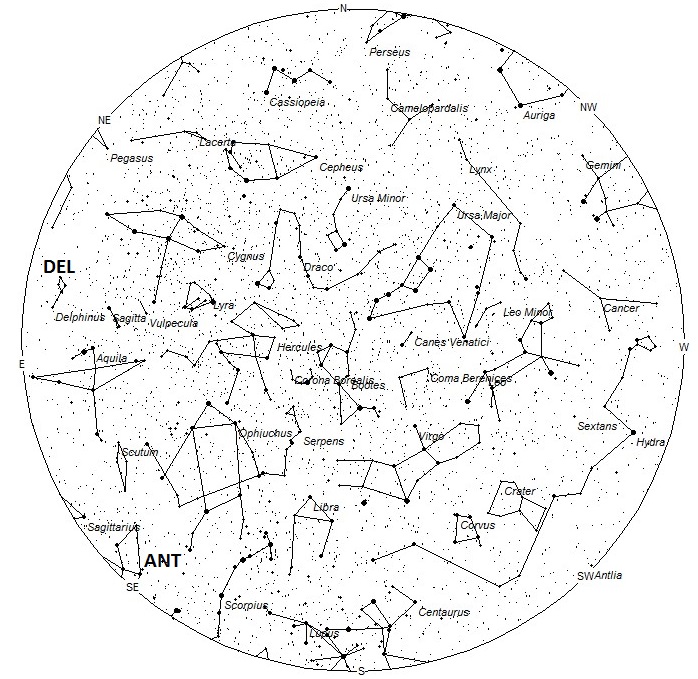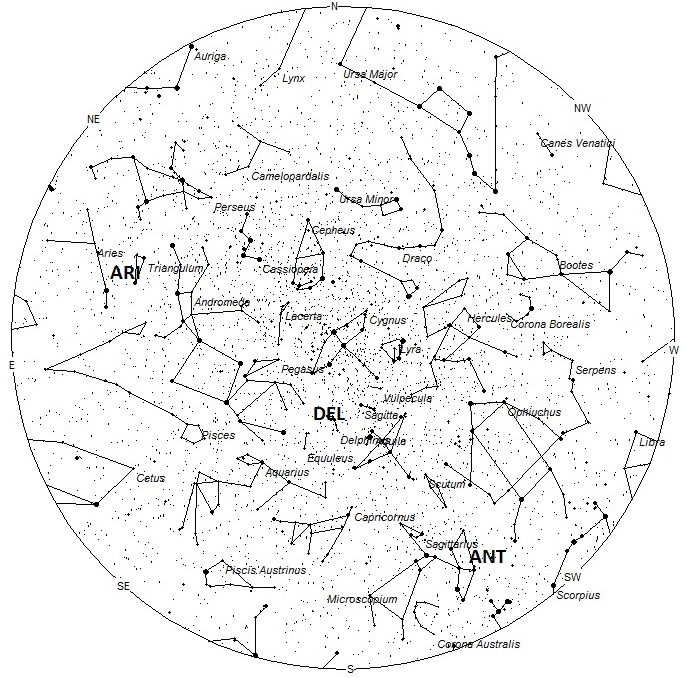During this period the moon reaches its new phase on Saturday June 8th. At this time the moon is located near the sun and is not visible at night. As the week progresses the waxing crescent moon will enter the evening sky but will set long before the more productive morning hours arrive. The estimated total hourly meteor rates for evening observers this week is near three as seen from the northern hemisphere and four as seen from south of the equator. For morning observers the estimated total hourly rates should be near eight as seen from the northern hemisphere and fourteen as seen from the southern hemisphere. The actual rates will also depend on factors such as personal light and motion perception, local weather conditions, alertness and experience in watching meteor activity.
The radiant (the area of the sky where meteors appear to shoot from) positions and rates listed below are exact for Saturday night/Sunday morning June 8/9. These positions do not change greatly day to day so the listed coordinates may be used during this entire period. Most star atlases (available at science stores and planetariums) will provide maps with grid lines of the celestial coordinates so that you may find out exactly where these positions are located in the sky. A planisphere or computer planetarium program is also useful in showing the sky at any time of night on any date of the year. Activity from each radiant is best seen when it is positioned highest in the sky, either due north or south along the meridian, depending on your latitude. It must be remembered that meteor activity is rarely seen at the radiant position. Rather they shoot outwards from the radiant so it is best to center your field of view so that the radiant lies at the edge and not the center. Viewing there will allow you to easily trace the path of each meteor back to the radiant (if it is a shower member) or in another direction if it is a sporadic. Meteor activity is not seen from radiants that are located below the horizon. The positions below are listed in a west to east manner in order of right ascension (celestial longitude). The positions listed first are located further west therefore are accessible earlier in the night while those listed further down the list rise later in the night.
The following showers are expected to be active this week:
The center of the large Anthelion (ANT) radiant is currently located at 18:04 (271) -23. This position lies in western Sagittarius, five degrees northeast of the third magnitude star known as Kaus Borealis (Lambda Sagittarii). These meteors may be seen all night long but the radiant is best placed near 0200 local daylight time (LDT) when it lies on the meridian and is highest in the sky. Rates at this time should be near two per hour as seen from the Northern hemisphere and three per hour from south of the equator . With an entry velocity of 30 km/sec., the average Anthelion meteor would be of slow velocity.
On the morning of June 11, there is the possibility of seeing a return of the Gamma Delphinids (DEL). These meteors have not been well seen since 1930, but there is hope that there may be some activity visible on this morning. The expected time of this activity is centered near 0828 Universal Time. This corresponds to 4:28 am EDT, 3:28 am CDT, 2:28 am MDT, and 1:28 am PDT. The timing is perfect for the Americas and the eastern Pacific including Hawaii. The predicted radiant is located at 20:48 (312) +17, which lies close to the notable double star Gamma Delphini. This area of the sky rises shortly after the end of dusk and is best placed in the sky between 0400 and 0500 LDT. A strong outburst is not expected but any activity would be notable. At 57km/sec., meteors from this source are expected to be of medium-swift velocity.
Your last good chance to see any activity from the Daytime Arietids (ARI) will occur this weekend. At 02:18 (046) +26, this radiant is located only thirty degrees west of the sun so visual observing conditions for this display are poor at best. It is an achievement of note just to see one of these meteors just before dawn on early June mornings. To try and see some of this activity, start watching one hour before the start of dawn and look toward the northeast with your center of vision positioned half-way up in the sky. Any Arietids will shoot upwards from the horizon and should last several seconds as they streak a long path through the sky. Your chances of seeing these meteors are best from the northern tropics, where the longer nights allow the radiant to rise higher into the sky. At 43km/sec. the Daytime Arietids would produce meteors of medium velocity. By the way, this is the strongest daylight shower of the year. If the circumstances were better for this shower (higher radiant in a dark sky), this display would rival the annual Perseids in intensity.
As seen from the mid-northern hemisphere (45N) one would expect to see approximately six sporadic meteors per hour during the last hour before dawn as seen from rural observing sites. Evening rates would be near two per hour. As seen from the mid-southern hemisphere (45S), morning rates would be near eleven per hour as seen from rural observing sites and three per hour during the evening hours. Locations between these two extremes would see activity between the listed figures.
The table below presents a list of radiants that are expected to be active this week. Rates and positions are exact for Saturday night/Sunday morning.
| SHOWER | DATE OF MAXIMUM ACTIVITY | CELESTIAL POSITION | ENTRY VELOCITY | CULMINATION | HOURLY RATE | CLASS |
| RA (RA in Deg.) DEC | Km/Sec | Local Daylight Time | North-South | |||
| Anthelions (ANT) | – | 18:04 (271) -23 | 30 | 02:00 | 2 – 3 | II |
| Gamma Delphinids (DEL) | Jun 11 | 20:48 (312) +17 | 57 | 05:00 | ? – ? | III |
| Daytime Arietids (ARI) | Jun 07 | 02:18 (046) +26 | 43 | 10:00 | <1 – <1 | IV |
 American Meteor Society
American Meteor Society


